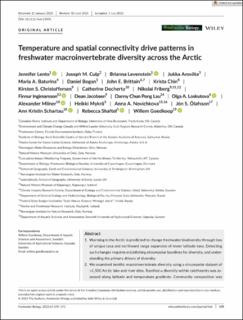Temperature and spatial connectivity drive patterns in freshwater macroinvertebrate diversity across the Arctic
| dc.contributor.author | Lento, Jennifer | |
| dc.contributor.author | Culp, Joseph M | |
| dc.contributor.author | Levenstein, Brianna | |
| dc.contributor.author | Aroviita, Jukka | |
| dc.contributor.author | Baturina, Maria A. | |
| dc.contributor.author | Bogan, Daniel | |
| dc.contributor.author | Brittain, John E | |
| dc.contributor.author | Chin, Krista | |
| dc.contributor.author | Christoffersen, Kirsten S. | |
| dc.contributor.author | Docherty, Catherine | |
| dc.contributor.author | Friberg, Nikolai | |
| dc.contributor.author | Ingimarsson, Finnur | |
| dc.contributor.author | Jacobsen, Dean | |
| dc.contributor.author | Lau, Danny Chun Pong | |
| dc.contributor.author | Loskutova, Olga A. | |
| dc.contributor.author | Milner, Alexander | |
| dc.contributor.author | Mykrä, Heikki | |
| dc.contributor.author | Novichkova, Anna A. | |
| dc.contributor.author | Ólafsson, Jón S. | |
| dc.contributor.author | Schartau, Ann Kristin | |
| dc.contributor.author | Shaftel, Rebecca | |
| dc.contributor.author | Goedkoop, Willem | |
| dc.date.accessioned | 2021-09-03T10:31:02Z | |
| dc.date.available | 2021-09-03T10:31:02Z | |
| dc.date.created | 2021-08-30T15:06:17Z | |
| dc.date.issued | 2022 | |
| dc.identifier.citation | Freshwater Biology. 2022, 67(1). | en_US |
| dc.identifier.issn | 0046-5070 | |
| dc.identifier.uri | https://hdl.handle.net/11250/2772820 | |
| dc.description.abstract | 1. Warming in the Arctic is predicted to change freshwater biodiversity through loss of unique taxa and northward range expansion of lower latitude taxa. Detecting such changes requires establishing circumpolar baselines for diversity, and understanding the primary drivers of diversity. 2. We examined benthic macroinvertebrate diversity using a circumpolar dataset of >1,500 Arctic lake and river sites. Rarefied α diversity within catchments was assessed along latitude and temperature gradients. Community composition was assessed through region-scale analysis of β diversity and its components (nestedness and turnover), and analysis of biotic–abiotic relationships. 3. Rarefied α diversity of lakes and rivers declined with increasing latitude, although more strongly across mainland regions than islands. Diversity was strongly related to air temperature, with the lowest diversity in the coldest catchments. Regional dissimilarity was highest when mainland regions were compared with islands, suggesting that connectivity limitations led to the strongest dissimilarity. High contributions of nestedness indicated that island regions contained a subset of the taxa found in mainland regions. 4. High Arctic rivers and lakes were predominately occupied by Chironomidae and Oligochaeta, whereas Ephemeroptera, Plecoptera, and Trichoptera taxa were more abundant at lower latitudes. Community composition was strongly associated with temperature, although geology and precipitation were also important correlates. 5. The strong association with temperature supports the prediction that warming will increase Arctic macroinvertebrate diversity, although low diversity on islands suggests that this increase will be limited by biogeographical constraints. Long-term harmonised monitoring across the circumpolar region is necessary to detect such changes to diversity and inform science-based management. benthic invertebrates, dispersal, diversity, high latitude, lake, river | |
| dc.language.iso | eng | en_US |
| dc.publisher | Wiley | en_US |
| dc.rights | Navngivelse 4.0 Internasjonal | * |
| dc.rights.uri | http://creativecommons.org/licenses/by/4.0/deed.no | * |
| dc.title | Temperature and spatial connectivity drive patterns in freshwater macroinvertebrate diversity across the Arctic | en_US |
| dc.type | Peer reviewed | en_US |
| dc.type | Journal article | en_US |
| dc.description.version | publishedVersion | |
| dc.source.pagenumber | 159-175 | en_US |
| dc.source.journal | Freshwater Biology | en_US |
| dc.identifier.doi | 10.1111/fwb.13805 | |
| dc.identifier.cristin | 1929820 | |
| dc.relation.project | EC/FP7/262693 | |
| cristin.ispublished | true | |
| cristin.fulltext | original | |
| cristin.qualitycode | 2 |
Tilhørende fil(er)
Denne innførselen finnes i følgende samling(er)
-
Publikasjoner fra Cristin - NIVA [2148]
-
Scientific publications [1172]

